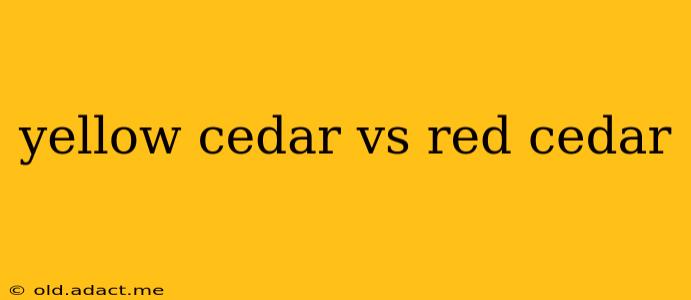Choosing the right type of cedar for your project can feel overwhelming, especially when faced with the similarities between yellow cedar and red cedar. Both are prized for their durability, beautiful grain, and aromatic qualities, but they possess distinct characteristics that make them suitable for different applications. This comprehensive guide will delve into the key differences between yellow cedar and red cedar, helping you make an informed decision.
What is Yellow Cedar?
Yellow cedar ( * Chamaecyparis nootkatensis* ), also known as Alaska yellow cedar, is a majestic conifer native to the coastal regions of North America. Its heartwood boasts a rich, golden-yellow hue, lending its name. This coloration, along with its fine, straight grain, makes it a highly sought-after wood for both interior and exterior applications. It’s prized for its exceptional rot resistance and durability, even in harsh climates.
What is Red Cedar?
Red cedar, most commonly referring to Western Red Cedar (Thuja plicata), is another iconic North American conifer species. Its heartwood exhibits a reddish-brown tone, although the color can vary depending on the tree's age and growing conditions. Like yellow cedar, it's renowned for its natural resistance to decay and insects, making it a popular choice for siding, decking, and interior finishes.
Yellow Cedar vs. Red Cedar: Key Differences
While both offer excellent durability and aesthetic appeal, several crucial distinctions set them apart:
Color and Grain:
- Yellow Cedar: Features a distinct golden-yellow to light brown heartwood with a fine, straight grain.
- Red Cedar: Displays a reddish-brown heartwood, although the color can range from light reddish-brown to a deeper, richer tone. The grain is generally straighter than that of many other cedar species but can sometimes show more variation than yellow cedar.
Durability and Rot Resistance:
- Yellow Cedar: Exhibits exceptional resistance to decay and insect infestation, exceeding that of many other cedar species. Its natural oils provide outstanding protection against rot, even in prolonged exposure to moisture.
- Red Cedar: Also possesses excellent rot and insect resistance, making it a reliable choice for outdoor projects. However, its resistance may be slightly less than that of yellow cedar, especially in extremely wet environments.
Strength and Hardness:
- Yellow Cedar: Generally stronger and harder than red cedar, making it more suitable for applications requiring greater structural integrity.
- Red Cedar: While durable, it’s softer and less dense than yellow cedar, making it easier to work with but potentially less suitable for high-stress applications.
Workability:
- Yellow Cedar: Can be slightly more challenging to work with due to its hardness, requiring sharper tools and potentially slower machining.
- Red Cedar: Relatively easy to work with, making it a preferred choice for DIY projects and those requiring intricate designs.
Cost:
- Yellow Cedar: Often more expensive than red cedar due to its superior durability, limited availability, and growing demand.
- Red Cedar: Generally more affordable and readily available, making it a budget-friendly option for various projects.
Uses:
- Yellow Cedar: Frequently used for high-end applications such as boat building, exterior cladding on high-end buildings, furniture, and millwork where exceptional durability and rot resistance are crucial.
- Red Cedar: Commonly used for siding, decking, fencing, interior paneling, and crafting due to its affordability, workability, and aesthetic appeal.
Is Yellow Cedar Better Than Red Cedar?
There's no universally "better" cedar; the ideal choice hinges on your specific project needs and priorities. Yellow cedar excels in applications requiring superior durability and rot resistance, while red cedar offers a balance of durability, affordability, and ease of workability.
What is the difference in cost between Yellow Cedar and Red Cedar?
The price difference can vary significantly based on location, availability, and the specific grade of lumber. Generally, yellow cedar commands a higher price than red cedar, reflecting its superior properties and lower supply.
Which cedar is better for outdoor use?
Both are excellent for outdoor use, but yellow cedar generally exhibits superior resistance to decay and insect damage, making it ideal for projects with prolonged exposure to the elements.
Which cedar is better for indoor use?
Both are suitable for indoor applications, offering aesthetic appeal and a pleasant aroma. However, red cedar's easier workability might make it preferable for projects involving intricate details.
This comprehensive comparison should help you confidently select the perfect cedar for your next project, whether it involves a sophisticated architectural design or a simple DIY creation. Remember to always consider your specific needs and budget when making your final decision.
